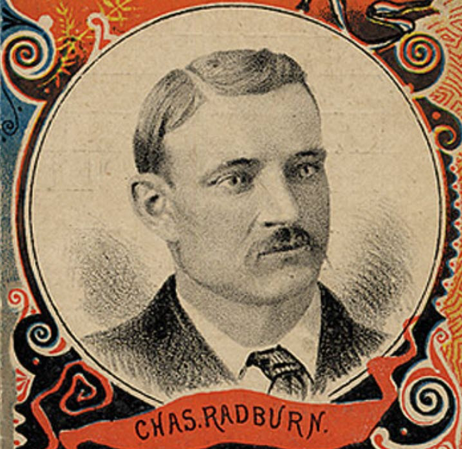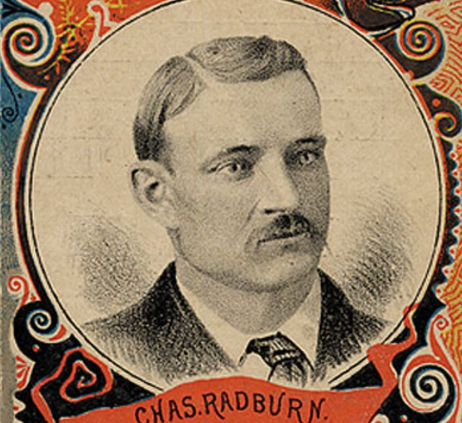June 14, 1884: Old Hoss Radbourn and Providence Grays prevail in 15 innings at Boston
Charles Radbourn “was an artist, perhaps the greatest the game has ever developed, in that he never wasted a ball. Every time he pitched he had some purpose in view, and his control was his stronghold.” – Alfred H. Spink, 19101
 With a population of 104,000 in 1884,2 Providence, Rhode Island, was a quintessential “small market” in the National League, yet the city’s Grays were a highly competitive team every year since joining the league in 1878. In 1883 Providence came in third in the NL, just five games behind the pennant-winning Beaneaters of Boston, who represented a city of 562,000.3
With a population of 104,000 in 1884,2 Providence, Rhode Island, was a quintessential “small market” in the National League, yet the city’s Grays were a highly competitive team every year since joining the league in 1878. In 1883 Providence came in third in the NL, just five games behind the pennant-winning Beaneaters of Boston, who represented a city of 562,000.3
Frank Bancroft became the Grays’ manager in 1884, replacing the venerable Harry Wright. The challenge for Bancroft was to figure out how his team could compete with the Beaneaters.
Bancroft could count on three veterans: 29-year-old outfielder Paul Hines, an outstanding hitter in his seventh season with the Grays; Joe Start, a 41-year-old first baseman and the team captain; and 29-year-old pitcher Charles “Old Hoss” Radbourn. From 1881 to 1883, Radbourn compiled an extraordinary 106-55 record for Providence, and his 48 wins in 1883 set a major-league record. “The secret of his pitching may be largely attributed to his coolness, perfect control of the ball and keen watchfulness of the weakness of the batsmen,” noted a Providence newspaper in 1884.4
Using a two-man rotation of Radbourn and 21-year-old Charlie Sweeney, the Grays got off to a great start in 1884 and achieved a 22-6 record through games of June 5. The season’s first meeting between the Grays and Beaneaters took place on June 6 in Providence, beginning a series of alternating home dates. Radbourn and Boston’s Jim Whitney dueled for 16 innings in a 1-1 tie.5 The next day, the action shifted 40 miles northeast to Boston, and the Grays edged the Beaneaters, 2-1, as Sweeney delivered a four-hitter and set a major-league record with 19 strikeouts. With this victory, Providence moved into a tie with Boston atop the NL standings.
But the Beaneaters won the next four meetings to knock the Grays back down in the standings. In Providence on June 9, Boston’s Charlie Buffinton hurled a two-hit shutout to defeat Sweeney, 2-0. The next day in Boston, Whitney fired a two-hitter and Sweeney was beaten again, 3-1. The Grays managed only four hits off Buffinton in Boston’s 4-1 triumph on June 11 in Providence. Radbourn’s pitching arm “was so lame that he had to pitch straight balls and trust to the fielders to keep the score down.”6 And in Providence on June 13, after a rainout in Boston, Buffinton again shut out the Grays, defeating Sweeney, 4-0.
The Grays had won only one of six games against their archrival and may have felt that their pennant hopes were slipping away. Facing the Whitney-Buffinton duo, the Grays had scored only five runs in six games and batted .141.7 In the seventh meeting, on Saturday, June 14, at Boston’s South End Grounds, the Grays would try again, with Radbourn going against Whitney.
The attendance was reported to be 5,420. The sole umpire was John Burns. The Grays wore “steel-grey shirts and pants, blue belts and stockings.”8 The Beaneaters were attired in white uniforms with red stockings and red cap.9 The Providence Star, referring to the Beaneaters as the “Reds,” reported that “every betting man who had a dollar to spare put it on the [heavily favored] Reds.”10 John Morrill, Boston’s first baseman and manager, could not play after spraining his ankle the day before,11 so Buffinton filled in for him at first base.
The Grays batted first. The first two innings were scoreless. In the top of third, Joe Start drew a walk on six balls from Whitney. (Six balls were required for a base on balls in 1884.) As Start attempted to steal second base, Boston catcher Mert Hackett threw the ball into center field. Center fielder Jimmy Manning retrieved it, and his throw in was also wild. Start came all the way around and scored the first run of the game.
The Beaneaters responded by scoring twice in the bottom of the third. Sam Wise led off with a double to center field. Joe Hornung “sent a hot one”12 to third baseman Jerry Denny, who deftly snagged it but threw wildly to first. Wise scored and Hornung reached second on the play. After Ezra Sutton struck out, Hornung advanced to third on an infield out. Whitney received a base on balls but got himself in a rundown between first and second. He was not tagged out; the ball was thrown home to get Hornung, who “made a pretty slide and scored, while the spectators yelled with merriment.”13
The Grays got a run in the fifth inning. Hines led off with a single and Start drew another base on balls. After Radbourn made an out, Arthur Irwin singled to load the bases. Denny lined the ball to the left-field corner. Hornung made a leaping catch, and Hines tagged up and scored. The game was now tied, 2-2.
The Beaneaters went back in front with a run in the sixth inning. With two outs, Manning doubled to center field, went to third base on a passed ball, and came home on Buffinton’s single. The Grays evened the score in the eighth inning. Paul Radford doubled to right field, moved to third base on Cliff Carroll’s single, and tallied on Barney Gilligan’s single. The game went to extra innings deadlocked at 3-3.
The Beaneaters had several scoring opportunities in extra innings but could not cash in. Manning singled in the 12th inning and reached third base but could not score. Likewise, Hornung doubled in the 13th inning and was stranded at third. With two outs and men on second and third in the 14th inning, the Beaneaters were thwarted once again. Carroll made a remarkable play in left field that even the Boston fans applauded. With his hands above his head, he leapt and deflected a line drive. The ball bounded up in the air and he caught it on the way down. It was a game-saving catch.
Finally, in the top of the 15th inning, the tie was broken by the Grays. With two outs, Radford doubled down the left-field line, and Carroll brought him in with a double to left-center field.14 Radbourn retired the Beaneaters in the bottom half, and the game was over. The final score was Providence 4, Boston 3.
Few fans left before “the last out had been made in the fifteenth inning, and as each man was retired and the game prolonged, while the score remained a tie, the excitement became intense,” reported the Boston Globe.15
With the win, Radbourn improved his season record to 13-3.16 He allowed seven hits and two walks in 15 innings and struck out 13 batters.
Whitney’s record fell to 13-6.17 He impressively fanned 18 batters, but he allowed 14 hits in the loss. Hackett, his batterymate, had a rough day. He “saved many wild pitches” but was charged with three passed balls and three “wild throws.”18 And in six at-bats, he struck out five times.
Epilogue
The Grays and Beaneaters met in a six-game series, July 11 to July 17, each team winning three. After Sweeney left the team on July 22, Radbourn carried the pitching load almost entirely by himself. He won four consecutive games against Boston from August 9 to August 14, and from August 21 to September 24, he pitched 20 consecutive games, winning 19. When the season concluded on October 15, he had an astounding 60-12 record, and the Grays won the pennant, 10½ games ahead of the second-place Beaneaters. To top it off, Radbourn won all three games as the Grays defeated the New York Metropolitans, champions of the American Association, in the first “World Series.”
Acknowledgments
This article was fact-checked by Stew Thornley and copy-edited by Len Levin.
Sources
In addition to the sources cited in the Notes, the author consulted Baseball-Reference.com and Retrosheet.org for pertinent information and reviewed game coverage in the June 15, 1884, issues of the Boston Globe and Providence Star.
Notes
1 Alfred H. Spink, The National Game, 1910, 62. Reprinted by Southern Illinois University Press in 2000.
2 “Notes and Comments,” Sporting Life, April 2, 1884: 3.
3 “Notes and Comments,” Sporting Life, April 2, 1884: 3.
4 “Radbourn’s Big Feat Unequaled,” New York Telegraph, November 20, 1905: 7.
5 “Sixteen Innings, Two Runs,” Boston Globe, June 7, 1884: 3.
6 Sporting Life, June 18, 1884: 3.
7 Computed by the author from box scores in “Big Base Ball,” Providence Star, June 7, 1884: 1; and Sporting Life, June 18, 1884: 3.
8 “Notes and Comments,” Sporting Life, March 26, 1884: 3.
9 Craig Brown, ThreadsOfOurGame.com, accessed August 2023.
10 “In the Fifteenth,” Providence Star, June 15, 1884: 1.
11 “Still Another,” Boston Globe, June 14, 1884: 4.
12 “Fifteen Innings,” Boston Globe, June 15, 1884: 5.
13 “Fifteen Innings.”
14 “Providence-Boston,” Chicago Inter Ocean, June 15, 1884: 3.
15 “Fifteen Innings.”
16 Determined by the author from published box scores.
17 Determined by the author from published box scores.
18 “Fifteen Innings.”
Additional Stats
Providence Grays 4
Boston Beaneaters 3
South End Grounds
Boston, MA
Corrections? Additions?
If you can help us improve this game story, contact us.


